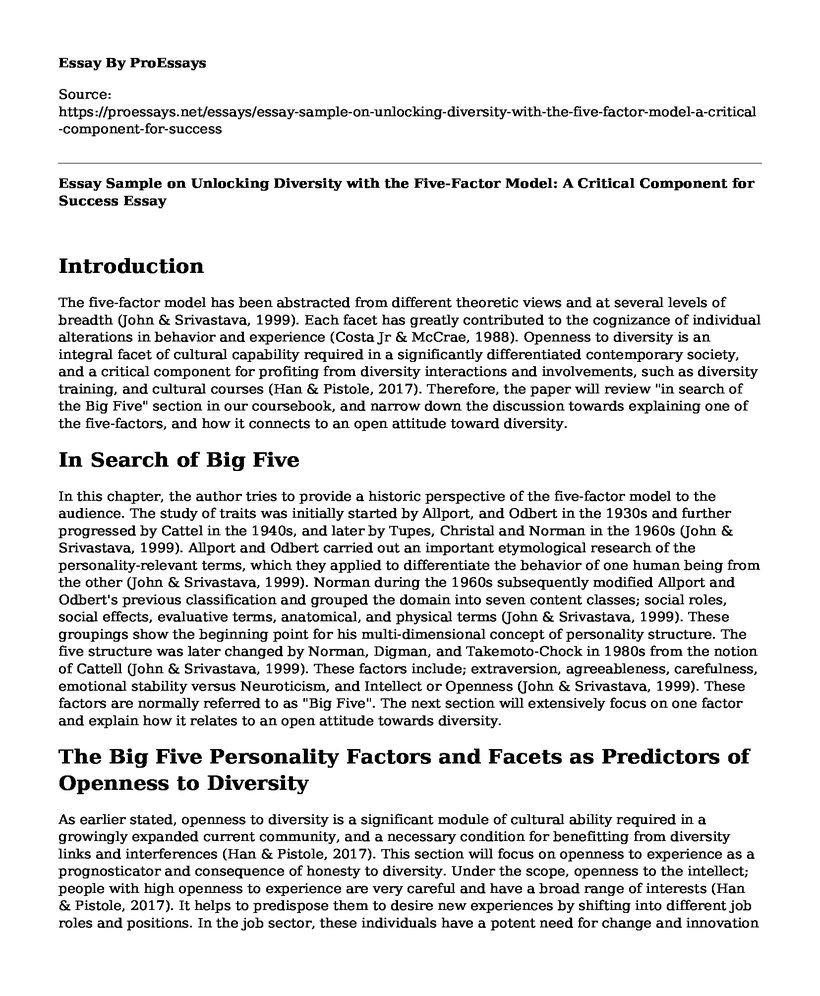Introduction
The five-factor model has been abstracted from different theoretic views and at several levels of breadth (John & Srivastava, 1999). Each facet has greatly contributed to the cognizance of individual alterations in behavior and experience (Costa Jr & McCrae, 1988). Openness to diversity is an integral facet of cultural capability required in a significantly differentiated contemporary society, and a critical component for profiting from diversity interactions and involvements, such as diversity training, and cultural courses (Han & Pistole, 2017). Therefore, the paper will review "in search of the Big Five" section in our coursebook, and narrow down the discussion towards explaining one of the five-factors, and how it connects to an open attitude toward diversity.
In Search of Big Five
In this chapter, the author tries to provide a historic perspective of the five-factor model to the audience. The study of traits was initially started by Allport, and Odbert in the 1930s and further progressed by Cattel in the 1940s, and later by Tupes, Christal and Norman in the 1960s (John & Srivastava, 1999). Allport and Odbert carried out an important etymological research of the personality-relevant terms, which they applied to differentiate the behavior of one human being from the other (John & Srivastava, 1999). Norman during the 1960s subsequently modified Allport and Odbert's previous classification and grouped the domain into seven content classes; social roles, social effects, evaluative terms, anatomical, and physical terms (John & Srivastava, 1999). These groupings show the beginning point for his multi-dimensional concept of personality structure. The five structure was later changed by Norman, Digman, and Takemoto-Chock in 1980s from the notion of Cattell (John & Srivastava, 1999). These factors include; extraversion, agreeableness, carefulness, emotional stability versus Neuroticism, and Intellect or Openness (John & Srivastava, 1999). These factors are normally referred to as "Big Five". The next section will extensively focus on one factor and explain how it relates to an open attitude towards diversity.
The Big Five Personality Factors and Facets as Predictors of Openness to Diversity
As earlier stated, openness to diversity is a significant module of cultural ability required in a growingly expanded current community, and a necessary condition for benefitting from diversity links and interferences (Han & Pistole, 2017). This section will focus on openness to experience as a prognosticator and consequence of honesty to diversity. Under the scope, openness to the intellect; people with high openness to experience are very careful and have a broad range of interests (Han & Pistole, 2017). It helps to predispose them to desire new experiences by shifting into different job roles and positions. In the job sector, these individuals have a potent need for change and innovation (Han & Pistole, 2017).
Again, individuals with high openness to experience may further be considered by their intellectual aptitudes and elasticity. It may also lead them to pursue intellectual growth in their occupation by taking on more mind-numbing jobs on high classified levels (Han & Pistole, 2017). Openness to experience is also effectively connected to divergent thinking, ingenuity, and it also leads to the generation of new ideas (Kaufman et al., 2016). Openness to experience is a facet that should be incorporated within the leaders in different organizations since it will assist to enhance diversity within the workplace (Kaufman et al., 2016). Additionally, workers with high openness to experience are more likely to opt to work in intricate, self-directed positions (Kaufman et al., 2016). These individuals positively contribute to spearheading necessary changes in the decision-making and specialized positions (Han & Pistole, 2017).
Openness and Intellect facet imply that honesty should predict creativity in the arts, however, that intellect should predict artistic achievement in the sciences (Kaufman et al., 2016). Openness encompasses inventive interests, but intellect includes interest in ideas. In 1983, Costa & McCrae realized that their NEO system carefully looked like three of the big five factors but did not include Sociability and Assiduousness spheres (Costa Jr & McCrae, 1988).
Conclusion
In conclusion, the paper has briefly reviewed the "in search of the Big Five" and extensively explained the openness to experience as a facet of promoting openness to diversity in the workplace. The five-factor model was conceptualized by Digman and Takemoto-Chock in 1980s. Finally, Openness to experience is also closely linked to divergent thinking, creativity, and it also leads to the generation of new ideas within the workplace.
References
Costa Jr, P. T., & cCrae, R. R. (1988). From catalog to classification: Murray's needs and the five-factor model. Journal of personality and social psychology, 55(2), 258. Retrieved from: file:///C:/Users/User/Downloads/No.102-Catalogtoclassification-MurraysneedsFFM.pdf
Han, S., & Pistole, M. C. (2017). Big five personality factors and facets as predictors of openness to diversity. The Journal of psychology, 151(8), 752-766. Retrieved from: https://www.tandfonline.com/doi/abs/10.1080/00223980.2017.1393377
John, O. P., & Srivastava, S. (1999). The Big Five trait taxonomy: History, measurement, and theoretical perspectives. Handbook of personality: Theory and research, 2(1999), 102-138. Retrieved from: http://t.personality-project.org/revelle/syllabi/classreadings/john.pdf
Kaufman, S. B., Quilty, L. C., Grazioplene, R. G., Hirsh, J. B., Gray, J. R., Peterson, J. B., & DeYoung, C. G. (2016). Openness to experience and intellect differentially predict creative achievement in the arts and sciences. Journal of personality, 84(2), 248-258. Retrieved from: https://scottbarrykaufman.com/wp-content/uploads/2015/01/Kaufman-et-al.-2015.pdf
Cite this page
Essay Sample on Unlocking Diversity with the Five-Factor Model: A Critical Component for Success. (2023, Mar 11). Retrieved from https://proessays.net/essays/essay-sample-on-unlocking-diversity-with-the-five-factor-model-a-critical-component-for-success
If you are the original author of this essay and no longer wish to have it published on the ProEssays website, please click below to request its removal:
- What I Learned From 4 Years Working at McDonald's
- Community Outreach Co-Coordinator Job Description - Paper Example
- Relationship of Corporate Social Responsibility Disclosureon Information Asymmetry
- Corporate Social Responsibility (CSR) and Business Ethics Essay
- Culture of Safety Awareness: Why Safety Programs Fail Paper Example
- Management in Action Paper Example
- HR Planning: Optimizing Employee Performance & Satisfaction - Essay Sample







